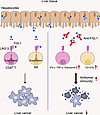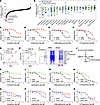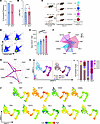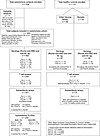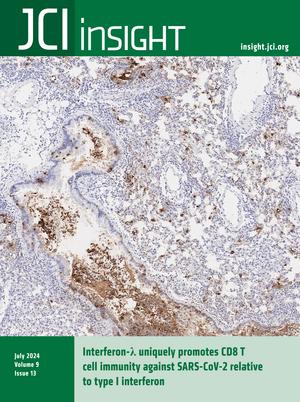
Issue published July 8, 2024
- Volume 9, Issue 13
- Previous Issue
Solstad et al. utilize a model of mouse-adapted SARS-CoV-2 to show that type III interferon signaling regulates DC function to promote SARS-CoV-2–specific CD8 T cell responses. The cover art shows images of murine lungs with broad distribution of SARS-CoV-2 nucleocapsid antigen in the absence of IFN-λ signaling following infection.
On the cover: Interferon-λ uniquely promotes CD8 T cell immunity against SARS-CoV-2 relative to type I interferon
In-Press Preview - More
Abstract
Solid organ transplantation remains the life-saving treatment for end-stage organ failure, but chronic rejection remains a major obstacle to long-term allograft outcomes and has not improved substantially. Tertiary lymphoid organs (TLO) are ectopic lymphoid structures that form under conditions of chronic inflammation, and evidence from human transplantation suggests that TLO regularly form in allografts undergoing chronic rejection. In this study, we utilized a mouse renal transplantation model and manipulation of the lymphotoxin alpha (LTα) – lymphotoxin beta receptor (LTβR) pathway, which is essential for TLO formation, to define the role of TLO in transplantation. We showed that intragraft TLO are sufficient to activate the alloimmune response and mediate graft rejection in a model where the only lymphoid organs are TLO in the allograft. When transplanted to recipients with a normal set of secondary lymphoid organs, the presence of graft TLO or LTα overexpression accelerated rejection. If the LTβR pathway was disrupted in the donor graft, TLO formation was abrogated, and graft survival prolonged. Intravital microscopy of renal TLO demonstrated that local T and B cell activation in TLOs is similar to that observed in secondary lymphoid organs. In summary, we demonstrated that immune activation in TLO contributes to local immune responses, leading to earlier allograft failure. TLO and the LTαβ-LTβR pathway are therefore prime targets to limit local immune responses and prevent allograft rejection. These findings are applicable to other diseases such as autoimmunity or tumors, where either limiting or boosting local immune responses is beneficial and improves disease outcomes.
Authors
Gang Zhang, Neda Feizi, Daqiang Zhao, Latha Halesha, Amanda L. Williams, Parmjeet S. Randhawa, Khodor I. Abou-Daya, Martin H. Oberbarnscheidt
Abstract
Upon infection, naïve CD8+ T cells differentiate into cytotoxic effector cells to eliminate the pathogen-infected cells. Although many mechanisms underlying this process have been demonstrated, the regulatory role of chromatin remodel system in this process remains largely unknown. Here we showed that BRD7, a component of the polybromo-associated BRG1-associated factor complex (PBAF), was required for naïve CD8+ T cells to differentiate into functional short-lived effector cells (SLECs) in response to acute infections caused by influenza virus or lymphocytic choriomeningitis virus (LCMV). BRD7-deficiency in CD8+ T cells resulted in profound defects in effector population and functions, thereby impairing viral clearance and host recovery. Further mechanical studies indicated that the expression of BRD7 significantly turned to high from naïve CD8+ T cells to effector cells, bridged BRG1 and PBRM1 to the core module of PBAF complex, consequently facilitating the assembly of PBAF complex rather than BAF complex in the effector cells. The PBAF complex changed the chromatin accessibility at the loci of Tbx21 gene and up-regulated its expression, leading to the maturation of effector T cells. Our research confirms BRD7 and the PBAF complex are key in CD8+ T cell development and present a significant target for advancing immune therapies.
Authors
Feng Huang, Yingtong Lin, Yidan Qiao, Yaochang Yuan, Zhihan Zhong, Baohong Luo, Yating Wu, Jun Liu, Jingliang Chen, Wanying Zhang, Hui Zhang, Bingfeng Liu
Abstract
Pulmonary disorders impact 40% to 80% of individuals with obesity. Respiratory muscle dysfunction is linked to these conditions; however, its pathophysiology remains largely undefined. Mice subjected to diet-induced obesity (DIO) develop diaphragmatic weakness. Increased intra-diaphragmatic adiposity and extracellular matrix (ECM) content correlate with reductions in contractile force. Thrombospondin-1 (THBS1) is an obesity-associated matricellular protein linked with muscular damage in genetic myopathies. THBS1 induces proliferation of fibro-adipogenic progenitors (FAPs) — mesenchymal cells that differentiate into adipocytes and fibroblasts. We hypothesized that THBS1 drives FAP-mediated diaphragm remodeling and contractile dysfunction in DIO. We tested this by comparing the effects of dietary challenge on diaphragms of wild-type (WT) and Thbs1 knockout (Thbs1–/–) mice. Bulk and single-cell transcriptomics demonstrated DIO-induced stromal expansion in WT diaphragms. Diaphragm FAPs displayed upregulation of ECM and TGF β-related expression signatures and augmentation of a Thy1-expressing sub-population previously linked to type 2 diabetes. Despite similar weight gain, Thbs1–/– mice were protected from these transcriptomic changes and from obesity-induced increases in diaphragm adiposity and ECM deposition. Unlike WT controls, Thbs1–/– diaphragms maintained normal contractile force and motion after DIO challenge. These findings establish THBS1 as a necessary mediator of diaphragm stromal remodeling and contractile dysfunction in overnutrition and a potential therapeutic target in obesity-associated respiratory dysfunction.
Authors
Eric D. Buras, Moon-Sook Woo, Romil Kaul Verma, Sri Harshita Kondisetti, Carol S. Davis, Dennis R. Claflin, Kimber Converso-Baran, Daniel E. Michele, Susan V. Brooks, Tae-Hwa Chun
Abstract
Beside suppressing immune responses, regulatory T cells (Tregs) maintain tissue homeostasis and control systemic metabolism. Whether iron is involved in Treg-mediated tolerance is completely unknown. Here, we showed that the transferrin receptor CD71 was upregulated on activated Tregs infiltrating human liver cancer. Mice with a Treg-restricted CD71 deficiency spontaneously developed a scurfy-like disease, caused by impaired perinatal Treg expansion. CD71-null Tregs displayed decreased proliferation and tissue-Treg signature loss. In perinatal life, CD71 deficiency in Tregs triggered hepatic iron overload response, characterized by increased hepcidin transcription and iron accumulation in macrophages. Lower bacterial diversity, and reduction of beneficial species, were detected in the fecal microbiota of CD71 conditional knock-out neonates. Our findings indicate that CD71-mediated iron absorption is required for Treg perinatal expansion and related to systemic iron homeostasis and bacterial gut colonization. Therefore, we hypothesize that Tregs establish nutritional tolerance through competition for iron during bacterial colonization after birth.
Authors
Ilenia Pacella, Alessandra Pinzon Grimaldos, Alessandra Rossi, Gloria Tucci, Marta Zagaglioni, Elena Potenza, Valeria Pinna, Ivano Rotella, Ilenia Cammarata, Valeria Cancila, Beatrice Belmonte, Claudio Tripodo, Giuseppe Pietropaolo, Chiara Di Censo, Giuseppe Sciumè, Valerio Licursi, Giovanna Peruzzi, Ylenia Antonucci, Silvia Campello, Francesca Guerrieri, Valerio Iebba, Rita Prota, Maria Di Chiara, Gianluca Terrin, Valerio De Peppo, Gian Luca Grazi, Vincenzo Barnaba, Silvia Piconese
Abstract
Rheumatoid arthritis (RA) management lean toward achieving remission or low-disease activity. In this study, we conducted single-cell RNA sequencing (scRNAseq) of peripheral blood mononuclear cells (PBMCs) from 36 individuals (18 RA patients and 18 matched controls, accounting for age, sex, race, and ethnicity), to identify disease-relevant cell subsets and cell type-specific signatures associated with disease activity. Our analysis revealed 18 distinct PBMC subsets, including an IFITM3 overexpressing Interferon-activated (IFN-activated) monocyte subset. We observed an increase in CD4+ T effector memory cells in patients with moderate to high disease activity (DAS28-CRP ≥ 3.2), and a decrease in non-classical monocytes in patients with low disease activity or remission (DAS28-CRP < 3.2). Pseudobulk analysis by cell type identified 168 differentially expressed genes between RA and matched controls, with a downregulation of pro-inflammatory genes in the gamma-delta T cells subset, alteration of genes associated with RA predisposition in the IFN-activated subset, and non-classical monocytes. Additionally, we identified a gene signature associated with moderate-high disease activity, characterized by upregulation of pro-inflammatory genes such as TNF, JUN, EGR1, IFIT2, MAFB, G0S2, and downregulation of genes including HLA-DQB1, HLA-DRB5, TNFSF13B. Notably, cell-cell communication analysis revealed an upregulation of signaling pathways, including VISTA, in both moderate-high and remission-low disease activity contexts. Our findings provide valuable insights into the systemic cellular and molecular mechanisms underlying RA disease activity.
Authors
Marie Binvignat, Brenda Y. Miao, Camilla Wibrand, Monica M. Yang, Dmitry Rychkov, Emily Flynn, Joanne Nititham, Whitney Tamaki, Umair Khan, Alexander Carvidi, Melissa Krueger, Erene C. Niemi, Yang Sun, Gabriela K. Fragiadakis, Jérémie Sellam, Encarnita Mariotti-Ferrandiz, David Klatzmann, Andrew J. Gross, Chun Jimmie Ye, Atul J. Butte, Lindsey A. Criswell, Mary C. Nakamura, Marina Sirota



